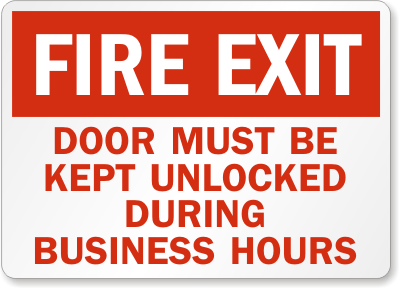Top 5 Fire Escape Tips for Your Business
 When a fire occurs in your place of business – no matter how many safeguards and fire suppression systems that you might have installed – the overriding concern is making sure that each and every employee evacuates as quickly as possible.
When a fire occurs in your place of business – no matter how many safeguards and fire suppression systems that you might have installed – the overriding concern is making sure that each and every employee evacuates as quickly as possible.
Business fire escape plans can face a number of challenges, including geographically-dispersed buildings, taller structures where exits are located far away from offices, and the presence of chemicals and other flammable materials that can pose substantial risk to evacuees.
In honor of National Fire Prevention week, October 7-13, 2012, here are five of the most important tips to consider when you’re putting together a business fire escape plan.
1. Fire Extinguisher Training. No one expects employees to risk their lives fighting a fire instead of evacuating as quickly as possible. That being said, by equipping an office, factory, or warehouse with an adequate number of fire extinguishers, as well as training workers in how to properly use them, it’s possible to give those trying to escape a better chance of making it outside the building safely. Fire extinguishers can be used en route to put out smaller fires blocking escape paths, or they can help keep flames under control until everyone can be safely evacuated from a section of the building.
2. Planning. Escape plans must be updated in order to reflect changes to the workplace – different cubicle assignments, new construction, or movement of inventory. It’s not enough to adopt a “set it and forget it” policy when it comes to fire escape planning. A reality check of each plan is also crucial to make sure that it avoids elevators, potential choke points where hallways become narrow, or exits into areas where obstacles, walls, or natural barriers would prevent workers from leaving the scene of the fire in a quick and efficient manner.
3. Practice. Practice. Practice. Escape drills should be done regularly – at least as often as you test your fire alarm system – and new employees should be introduced to the fire escape plan as quickly as possible. Designate fire leaders on each floor of your building and make sure they understand each escape route, the number of employees they are responsible for, and their roles in ensuring everyone has left the building safely. They can do that by taking a headcount.
4. Maintain Your MSDS Sheets. Material safety data sheets (MSDS) are important for companies that handle flammable chemicals or products. When planning fire escape routes, take into account the MSDS sheets associated with inventory stored in a given building, and avoid sending workers toward materials that could pose safety risks. Update escape plans as often as needed when new, potentially hazardous inventory is housed.
5. Keep Exits Clear And Unlocked. You know that door at the back of the warehouse that no one ever uses – the one with the Fire Exit sign illuminated over top of it? You need to ensure that the area immediately in front of the door – on either side of it – doesn’t become a stacking ground for boxes, equipment, or other items. It’s also crucial to keep these doors unlocked and unchained. If you must, install an alarm that goes off should the door be opened (for access control), but ensure that a push from the inside will instantly open it up and allow employees to escape.
